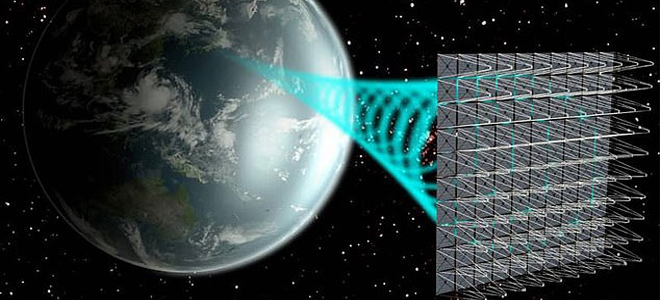
A pizza box sized solar panel in orbit is producing enough electricity to power an iPad, according to a succesful test of the technology by the US Navy. The Photovoltaic Radiofrequency Antenna Module (PRAM) was launched in May 2020 attached to a drone that loops around the Earth every 90 minutes and is designed to harness light from the sun to convert to electricity. The 12×12 inch panel is an early experiment for a technology that could one day harness solar radiation from the sun and beam it to anywhere on the Earth.
It is designed to make the best use of light in space, which doesn’t have to pass through the atmosphere where it loses energy before reaching the ground.
The Pentagon one day envisages an array of panels in space that could send power to even the most remote parts of the planet and create a new global power grid. No details on timelines or costings have been revealed as part of the study.
‘To our knowledge, this experiment is the first test in orbit of hardware designed specifically for solar power satellites, which could play a revolutionary role in our energy future,’ said Paul Jaffe, PRAM principal investigator. ‘Some visions have space solar matching or exceeding the largest power plants today – multiple gigawatts – so enough for a city,’ he told CNN.
While this test technology can’t ‘beam power’ to the planet below, future versions could do just that – as the technology has already been shown to work. ‘The unique advantage the solar power satellites have over any other source of power is this global transmissibility,’ Jaffe said. ‘You can send power to Chicago and a fraction of a second later, if you needed, send it instead to London or Brasilia.’
The use of solar energy to operate satellites began at the start of the space age with Vanguard I, the first satellite to have solar cells. The concept of using solar panels in space, where the energy levels are higher, then beaming that power to the Earth isn’t a new concept.
It’s an idea first conjured by science-fiction writer Isaac Asimov in 1941 in his science fiction short story Reason where it was revealed a station a mile across was used as an ‘energy converter’ to gather sunlight and beam it across the solar system. Japan, China, Russia, the UK, and the US are all pursuing the idea of space-based power generation and Japan has it listed as a national goal.
This current experiment focuses on the energy conversion process and resulting thermal performance, a Navy spokesperson said. The hardware will provide researchers with temperature data, along with its efficiency in energy production that will drive future space solar development.
The point of this study is to determine whether space solar technology can be delivered at an economically viable price-point, the team said. Jaffe explained that ‘building hardware for space is expensive’ but that the costs are starting to come down, especially over the past decade.
This module is sat on the highly secretive US’ X-37B space plane – in fact, the module is the only aspect of the mission widely known – but future versions could be in a geosynchronous orbit around the Earth.
dailymail

